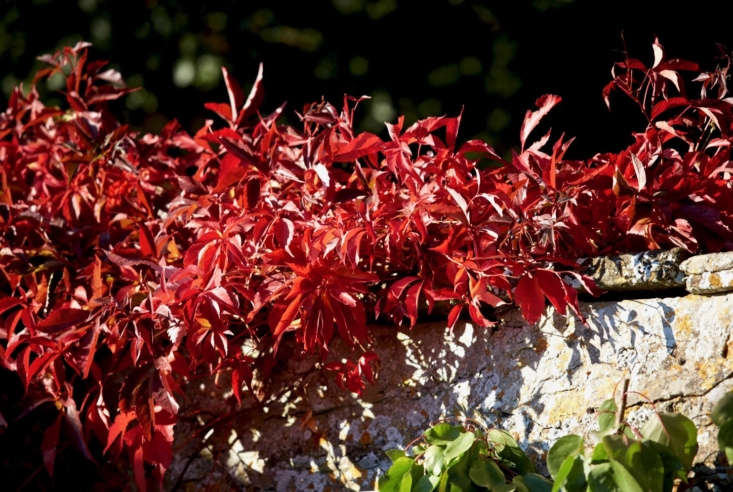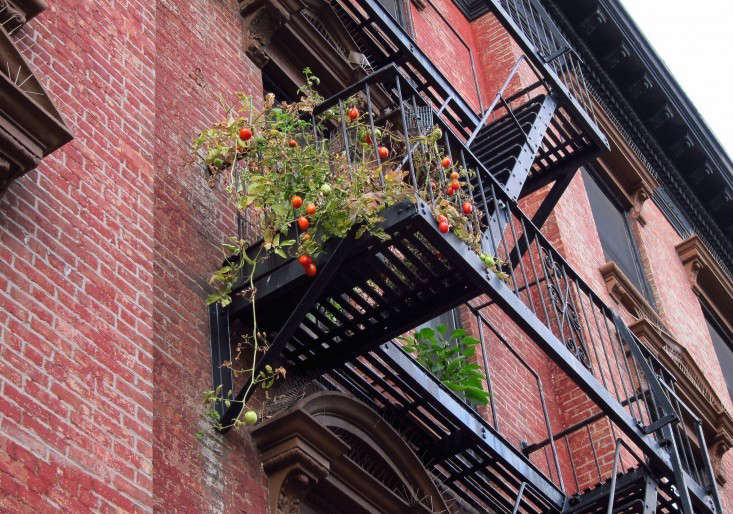Virginia Creeper, Parthenocissus quinquefolia
When it comes to vines and climbers, would you rather have a pet leopard or a house cat? This is the difference between Virginia creeper and Boston ivy, two plants frequently confused because of the similar shapes of their leaves and the tendency of both to turn a brilliant scarlet in autumn. But remember: Virginia creeper is less commonly cultivated in domestic situations for a good reason. It has a wild nature.
Native to Virginia but not a creeper (unless you consider its way of traveling underground, with spreading rhizomes), Parthenocissus quinquefolia is a bit like the leopard in Bringing Up Baby; it is only just manageable. Following is some advice, then, if you happen to have Virginia creeper, without necessarily seeking it out (remember Cary Grant’s predicament with Baby: “I won’t take him” and Katharine Hepburn’s response: “You got him.”)
Photography by Britt Willoughby Dyer, for Gardenista, except where noted.

Native to the eastern United States, Virginia creeper is not always welcome elsewhere, because it tries to escape into the wilderness. The Royal Horticultural Society advises considering alternative climbers, described in a useful booklet published in collaboration with Plantlife called Gardening without Harmful Invasive Plants. One suggestion is grape vine, which is part of the same family as Virginia creeper.
Like its other close relation Boston ivy, Virginia creeper is hardy all over most of the the United States (in USDA growing zones 3-9). It is even more vigorous than its relations, reaching heights of from 40 to 50 feet and setting up camp at the tops of trees. However, with a little care, it can be kept within a restricted area, like the specimen next door to me (pictured above). Where its climbing ambitions have been frustrated—on the second floor—it hangs down in vines like a curtain.

For information on tamer Boston ivy, see: Gardening 101: Boston Ivy.

Virginia creeper is heaven for birds and insects, providing food and roosting opportunities where it is allowed to flow freely. Native plants host a wider variety of native wildlife, and climbers are particularly noted as shelter for invertebrates. For a wild garden, or a relaxed front path, growing Virginia creeper is an act of generosity.

Cheat Sheet
- Virginia creeper grows up buildings just as happily as it grows up trees, attaching itself with aerial tendrils and adhesive pads. It does not damage mortar but its weight, if allowed to hang down in vines, can be problematic when in leaf.
- Like Boston ivy, Virginia creeper is deciduous, putting on a spectacular display in the fall. A west- or south-facing aspect is most effective in encouraging color.
- Resembling poison ivy, it is not poisonous as such but can cause a rash, so gloves are a good idea when handling Parthenocissus quinquefolia. Its small dark blue berries, which look good against the flaming reds in autumn, are toxic.

Keep It Alive
- Virginia creeper is as undemanding as common ivy (pictured above), thriving in any kind of soil, with any level of acidity. (Ideally soil would be well-drained and moist.)
- It is fully hardy and puts up with exposure. Grown against a building, it has cooling properties in summer. Untrimmed, it looks like a shaggy beard in winter.
- Virginia creeper is difficult to get rid of, not least because of its habit of spreading through rhizomes, which result in unscheduled appearances of the plant above ground. Keep the vines in check, chop its stem at the base if you must, but try not to poison it.
See more growing tips at Virginia Creeper: A Field Guide to Planting, Care & Design in our curated guides to Vines & Climbers 101. For more ways to add curb appeal to Exteriors & Facades, see:









Have a Question or Comment About This Post?
Join the conversation